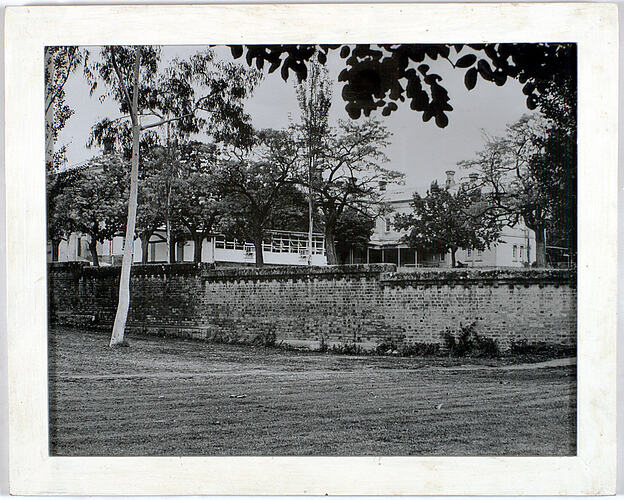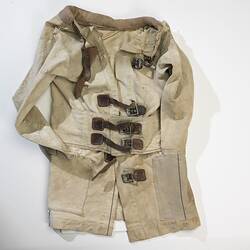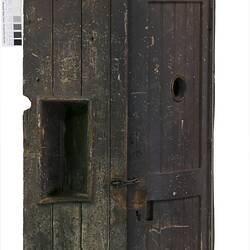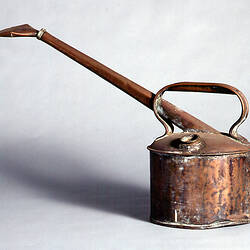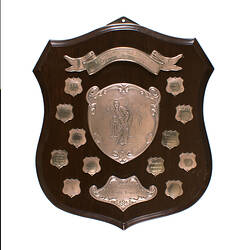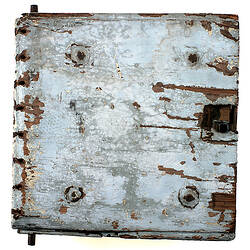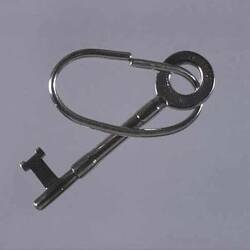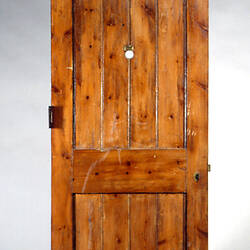Summary
An account of the confinement and seclusion of patients in psychiatric hospitals in Victoria Australia from the 1850s to the end of the 1960s.
In the 1850s, the population of Victoria exploded and the consequent demand for mental health admissions overwhelmed the colony's only public asylum, the Yarra Bend. It forced the government to resort to a number of makeshift measures, including confining patients in gaols (Malcolm, 2009, p.50), which met with considerable criticism and detractors arguing that the object in confining the insane was to cure, not punish. Dr Charles Stilwell (1862) explained, it was:
very important, that Lunatic Asylums should be, in fact, and character, considered and managed as hospitals for the medical and moral treatment of insanity.All the inmates alike should be taught to feel that the object of their being placed there is recovery from mental disease, for which temporary seclusion from general society is one of the means of treatment. The construction and arrangement of the buildings and grounds, and the entire system of management, should therefore as far as possible, be divested of the idea of confinement (pp 95-6).
When the government decided to build a second metropolitan asylum in Kew, its architects were concerned to minimise the sense of confinement. In 1876, journalist John Stanley James took work as an attendant at Kew. On first approaching the building, he was immediately struck by 'the enclosures in front of the wings on each side' where the patients appeared to be 'confined only by low walls, a few feet high - the deep dry moat or 'ha-ha' on the other side' being invisible (Vagabond, 1877, pp.79-80). This arrangement allowed the patients to enjoy the views of the surrounding landscape while protecting against the possibility of escape (Malcolm, 2009, pp.54-5). Other measures intended to reduce the sense of confinement included the installation of 'silent action asylum locks' which, because inaudible on opening, 'would not draw patients' attention to the custodial nature of the institution' (Malcolm, 2009, p.55). Nonetheless, the asylum was a custodial institution and patients were not simply free to leave.
Patients experienced different degrees of confinement. Many, remained confined to their ward or to the exercising-yards, under the supervision of attendants (Vagabond, 1877, pp.92, 99-100). A small number enjoyed more freedom, working on the asylum farm, in the gardens, or in the trade workshops and laundries, usually under the supervision of attendants but occasionally unwatched, or participating in organised recreations (MacKinnon, 2009, 130; Vagabond, 1877, pp.133, 127). In 1876, the Vagabond described walking with a group of about thirty patients - 'of course all good cases' - in the Asylum reserve, strolling under the trees to the river before sitting awhile to enjoy the view across Heidelberg to the Dandenongs, where 'the grateful prospect, for a time, soothed the minds of all' (Vagabond, 1877, p.136). The medical officers permitted a fortunate few to walk freely about the paddocks around the asylums 'or to go in to the town for a day' (Vagabond, 1877, p.102; Robertson, 1870).
In contrast, the practice of seclusion, of confining a patient to a single room or padded room for short periods, restricted their liberty further. As the use of straitjackets and other mechanical restraints fell in the late 1850s, seclusion took its place, and was used to manage difficult behaviours such as violence, abusive or foul language, excitement, escape, self-harm or injury to others (Smith, 1999, pp.272-3; PROV, VPRS 7400/P1, Unit 1, passim).
While the restrictions on movement and use of seclusion continued into the twentieth century (PROV, VPRS 7689/P1, Unit 1; VPRS 8257/P1, Units 1-5), they were not without their critics. In 1903 Dr John Springthorpe, recently appointed Official Visitor to the Metropolitan Asylums, condemned the degree of confinement patients endured, when compared with asylums overseas:
For years in the New York asylums, the policy of open doors.but still with us locks and keys!.For the New York insane, freedom of exercise.but with us, more than half the total number of patients confined all day long within high walls! (Springthorpe, 1903, pp.115-16)
Two decades later, Dr John Adey, the Medical Superintendent at the Sunbury Hospital for the Insane, made a significant change to the restraint on liberty by removing some of the barriers to patient freedom. Two of the male wards at the hospital were 'thrown open and handles fixed to the doors and gates, so that liberty patients can have free access to the wards. This', he declared, 'has been most satisfying, and no patients have escaped from these wards' (Report of the Inspector-General of the Insane 1923, p.18).
By 1925, some patients were straying beyond the hospital, prompting the Inspector-General of the Insane, Dr W. Ernest Jones, to include a section headed 'Escapes' in his annual report for the first time. He insisted that 'the project' to increase patient freedoms had not failed as most escapes were 'technical rather than actual'(Jones, 1929). He conceded however that, 'Particularly at Mont Park, where patients are given the freedom of the grounds, and again at Sunbury, where also certain wards, have been tried as open wards, the number of escapes has increased' (Report of the Inspector-General of the Insane 1925, p.14).
In 1951 the Mental Hygiene Medical Officers Association organised a symposium on 'Restraint, Seclusion, Freedom and Occupation' during which speakers highlighted the value of seclusion in episodes of chronic psychosis, the need for improved monitoring by authorities of confinement and seclusion, and the adverse impact of premature freedom on the recovery of some patients. Speakers also addressed the paradox that treatment and care in mental health hospitals could exacerbate frustration and aggression, sometimes creating the conditions for further restrictions on freedom (Minutes of the Mental Hygiene Medical Officers' Association, 16 May 1952).
When Dr Eric Cunningham Dax arrived to take up his post as head of Victoria's Mental Hygiene Authority the following year, he observed that the use of 'solitary seclusion' was 'considerable' (Dax, 1961, p.21). The Authority set about giving patients more freedom, pulling down the padded rooms (Dax, 1961, p.25). By 1955, Dax was able to declare that the Male Acute Ward at Royal Park was completely 'open'. 'There are no locks' he said, adding that the Female Acute Ward was being altered and much the same situation would apply once these were completed (Mental Health Federation of Australia, 1955). Six years later, reflecting on the reforms of the previous decade, he explained that the 'freedom' of the patients:
has continuously been extended in the long-stay hospitals while the early treatment units or receiving houses are completely open. The padded rooms, the railings, the fences and the retaining wires were removed and locked doors gradually opened by achieving a better classification of the patients and more adequate treatment and occupation (Dax, 1961, p.48).
Elsewhere Dax referred to the growing trend to manage patient behaviour by medicinal drugs as well as through social activities and occupational therapy - rather than mechanical or physical - means (Larkin, 1969, p.6). Nonetheless the use of seclusion and confinement continued, as strictly regulated management options with clear guidelines as to their use (Vine, 2011).
References
Dax, E. Cunningham (1961) Asylum to Community: The Development of the Mental Hygiene Service in Victoria, Australia, Melbourne, F W Cheshire
Jones, W. Ernest (1929), re escapes and recaptures of Voluntary Boarders, Memo 121, PROV, VPRS 7555/P1, Unit 3
Larkin, John (1969), 'My Main Worry: Average people', Age, September 9, p. 6
MacKinnon, Dolly (2009), 'Music, Sport and Recreation as Medicinal in Australian Asylums 1860s-1945', Health and History Special Issue: Australian Asylums and their Histories, vol 11, no 1, pp.128-48
Malcolm, Elizabeth (2009), 'Australian Asylum Architecture through German Eyes: Kew, 1867', Health and History Special Issue: Australian Asylums and their Histories, vol 11, no 1, pp.46-64
Mental Health Federation of Australia (1955), Minutes, State Library of Victoria, Mental Health Auxiliaries Collection, PA 89/140, Box 3/13
Minutes of the Mental Hygiene Medical Officers' Association (16 May 1952), Royal Melbourne Hospital, Victorian Mental Health Collection
PROV, VPRS 7400/P1, Unit 1
PROV, VPRS 7689/P1, Unit 1
PROV, VPRS 8257/P1, Units 1-5
Victorian Parliamentary Papers, Vol II
Report of the Inspector General of the Insane for 1923 (1925), Victorian Parliamentary Papers, Vol. II
Report of the Inspector General of the Insane for 1925 (1927), Victorian Parliamentary Papers, Vol. II
Robertson, Alexander, 1870, to the Inspector, 28 February, PROV, VPRS 3991/P, Box 478, File 1870/W1826
Smith, Leonard (1999), 'Cure, Comfort and Safe Custody': Public Lunatic Asylums in Early Nineteenth-Century England, London, Leicester University Press
Springthorpe, John (1903), 'Our Metropolitan Asylums', Intercolonial Medical Journal of Australasia, vol. VIII, no. 3, pp.109-24
Stilwell, Charles (1862), 'Some Remarks on the Treatment of the Insane', Australian Medical Journal, April 1862, pp.88-100
The Vagabond (John Stanley James) (1877), 'Our Lunatic Asylums: Record of the Experiences of a Month in Kew and Yarra Bend', The Vagabond Papers: Sketches of Melbourne Life in Light and Shade, First Series, Melbourne: George Robertson
Vine, R (2011), 'Chief Psychiatrist's Guidelines; Seclusion in Approved Mental Health Services', http://www.health.vic.gov.au/mentalhealth/cpg/seclusion-cpg-1103001.pdf, accessed 5 November 2011
More Information
-
Keywords
-
Authors
-
Article types
